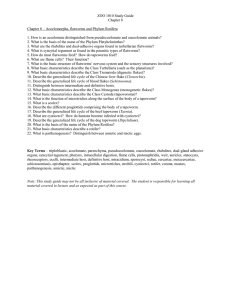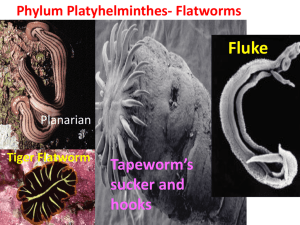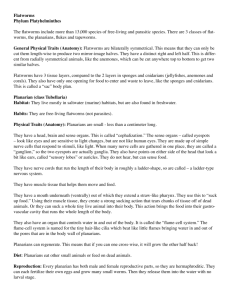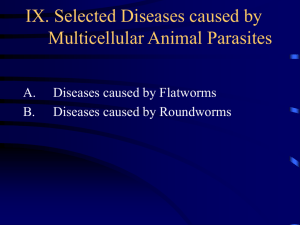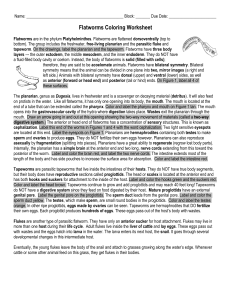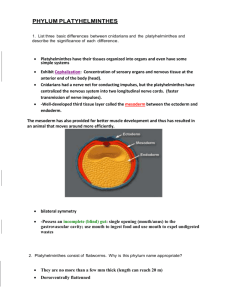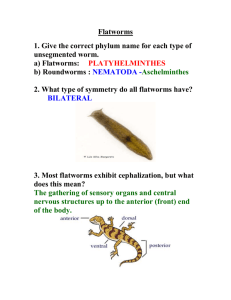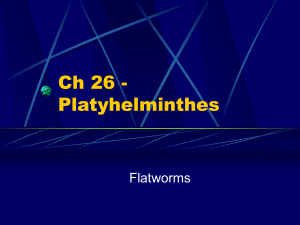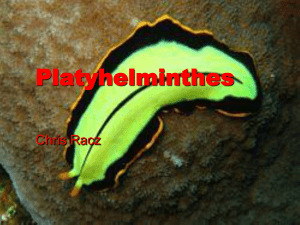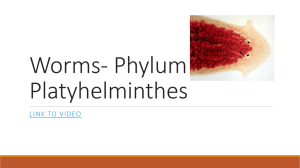File
advertisement
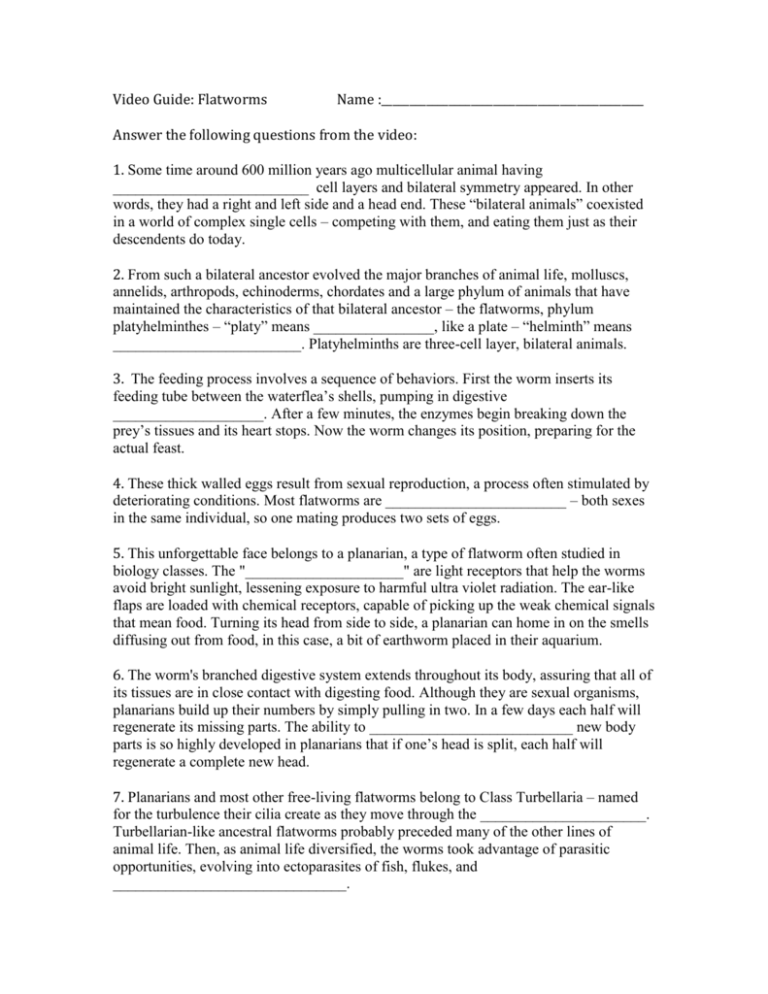
Video Guide: Flatworms Name :_______________________________________________ Answer the following questions from the video: 1. Some time around 600 million years ago multicellular animal having __________________________ cell layers and bilateral symmetry appeared. In other words, they had a right and left side and a head end. These “bilateral animals” coexisted in a world of complex single cells – competing with them, and eating them just as their descendents do today. 2. From such a bilateral ancestor evolved the major branches of animal life, molluscs, annelids, arthropods, echinoderms, chordates and a large phylum of animals that have maintained the characteristics of that bilateral ancestor – the flatworms, phylum platyhelminthes – “platy” means ________________, like a plate – “helminth” means _________________________. Platyhelminths are three-cell layer, bilateral animals. 3. The feeding process involves a sequence of behaviors. First the worm inserts its feeding tube between the waterflea’s shells, pumping in digestive ____________________. After a few minutes, the enzymes begin breaking down the prey’s tissues and its heart stops. Now the worm changes its position, preparing for the actual feast. 4. These thick walled eggs result from sexual reproduction, a process often stimulated by deteriorating conditions. Most flatworms are ________________________ – both sexes in the same individual, so one mating produces two sets of eggs. 5. This unforgettable face belongs to a planarian, a type of flatworm often studied in biology classes. The "_____________________" are light receptors that help the worms avoid bright sunlight, lessening exposure to harmful ultra violet radiation. The ear-like flaps are loaded with chemical receptors, capable of picking up the weak chemical signals that mean food. Turning its head from side to side, a planarian can home in on the smells diffusing out from food, in this case, a bit of earthworm placed in their aquarium. 6. The worm's branched digestive system extends throughout its body, assuring that all of its tissues are in close contact with digesting food. Although they are sexual organisms, planarians build up their numbers by simply pulling in two. In a few days each half will regenerate its missing parts. The ability to ___________________________ new body parts is so highly developed in planarians that if one’s head is split, each half will regenerate a complete new head. 7. Planarians and most other free-living flatworms belong to Class Turbellaria – named for the turbulence their cilia create as they move through the ______________________. Turbellarian-like ancestral flatworms probably preceded many of the other lines of animal life. Then, as animal life diversified, the worms took advantage of parasitic opportunities, evolving into ectoparasites of fish, flukes, and _______________________________. 8. The next time you go fishing, look closely at the fins of your catch. You may see a monogenetic flatworm hanging on with its powerful tail __________________________. 9. Lung flukes feed upon the linings of the lungs, breaking down the lung tissue and gorging on blood. The mature lung flukes are little more than sacks of reproductive organs manufacturing thousands of eggs. The eggs are coughed up by the frog, swallowed and shed into the pond with the frog's feces. Within each egg develops a ciliated larva that goes off in search of the first host in the lung fluke's life cycle – a pond _______________________________. 10. Frogs are not alone in having fluke problems. Every kind of animal has them, and all of these parasites have complex lifecycles involving snails or clams, suggesting that the flukes first evolved as parasites of ________________________. The sexually mature flukes come in all sizes, each adapted by its shape and behavior for life in a particular organ of its host. 11. Tapeworms are distinguished by having bodies made up of chains of reproductive individuals called proglottids. At times, you may have seen these egg-loaded proglottids emerging from a pet. The chain of proglottids that make up a tapeworm are kept within the intestine by one specialized individual at the head of the chain – the _____________________________________. 12. In Tanea solium, a tapeworm of humans, the intermediate host is a pig that has ingested human feces containing the tapeworm eggs, still a possibility in many areas of the world. The tapeworm embryos hook their way through the pig’s intestinal wall, where they are carried by the blood stream to the _____________________________. Here they form small, encapsulated tapeworm embryos. 13. When the pork is eaten without sufficient cooking the embryos digests out and grow into a mature intestinal parasites. A large tapeworm is an unwelcome guest, but the situation becomes much worse if the human, instead of the pig, ingests the tapeworm eggs. In this case the ________________________ burrow through the human's intestinal wall and form cysts in muscles and organs. 14. Flatworms are an ancient line of animal life with four surviving branches: Class Turbellaria, the free-living flatworms, Class Monogenea- ectoparasites of fish and amphibians, Class Trematoda, the flukes, and Class Cestoda, the tapeworms. Even before these lines began their evolutionary divergence, flatworm-like ancestors with _________________________-cell layers and bilateral symmetry opened the door for the great evolutionary experiments that produced the diversity of animals living today.
